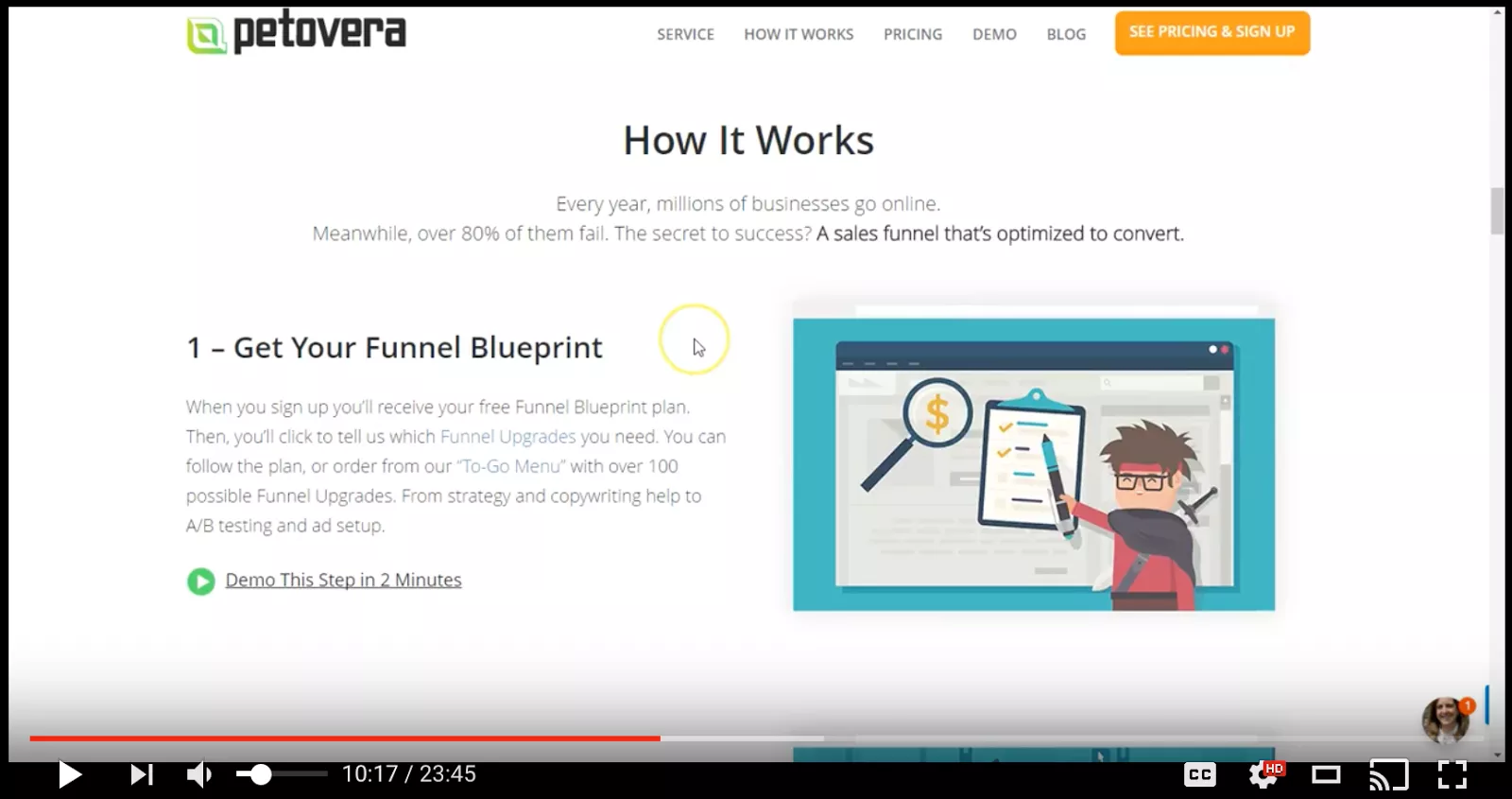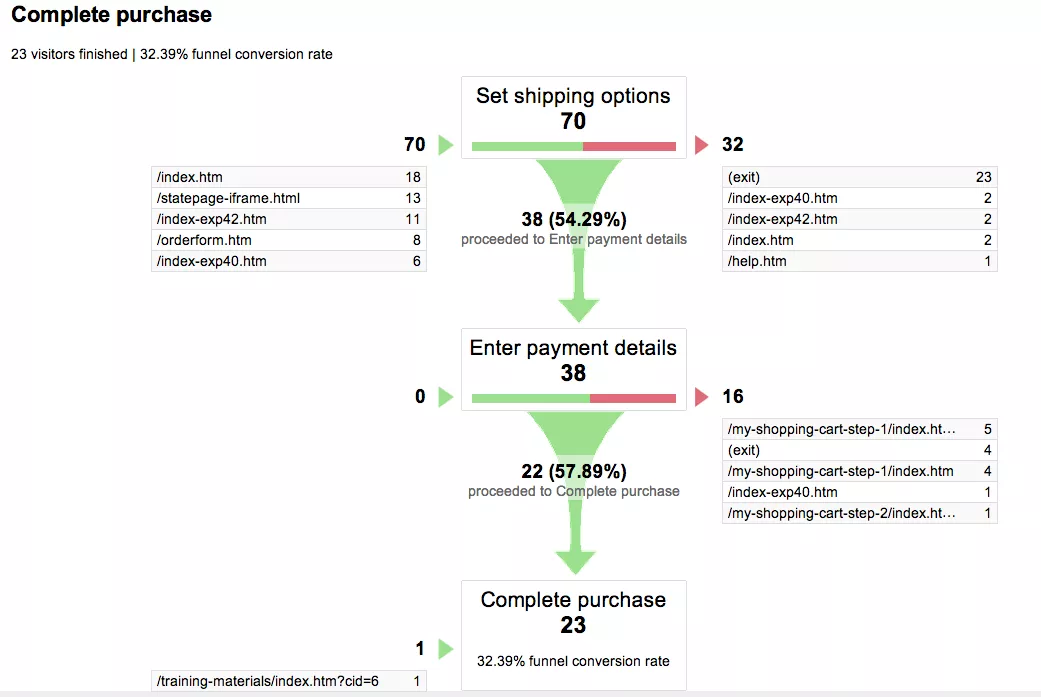5 Fast Ways to Find the Biggest Holes in Your Sales Funnel

I was hunched over my laptop. I kept hitting refresh.
The sales should have been rolling in.
After weeks of going back and forth, I had finally done it.
It was one of the biggest changes to our marketing funnel since we launched the new service last December.
We went from offering a $1 trial sign-up with a more complicated offer—to a free one. We had also dramatically simplified our service.
From all counts, it seemed like we were ticking off all the boxes for growth.
But staring into my monitor that Thursday night I felt completely lost.
No sales. No trials. Nothing.
“Damn. What’s the problem? I just can’t see where the hole is. . . .”
Maybe you know what that feels like.
You put the pedal to the medal, but nothing happened.
It can seem like there’s something stopping you from going forward. Like a block wedged in front of the wheel.
So what can you do?
Well, one of the biggest things I’ve learned from working in sales funnel optimization is to always utilize the data to “plug the holes” in your funnel.
But, sometimes it can be more complex than that. You have to dig deeper.
So today, I’m going to give you a host of solutions you may not have considered before.
I’m going to show you how to find the biggest holes in your sales funnel and how to plug them by integrating everything from real-life user feedback to a little something I like to call “micro A/B testing.”
Shall we get started?
1. Start With Web-Based User Testing (With Written Feedback & Recorded Video)

I’m going to kick this off by sharing one of my most trusted go-to fixes: web-based user testing.
What is it? It means getting user feedback about your website.
User testing is helpful in everything from generating ideas for structural improvements to changing your web design to pivoting your copywriting.
The best way to take advantage of this is to ask the user to video record the experience, so you can see his/her thoughts and impressions—in real-time.
I’ve done this multiple times for AutoGrow. Each time I get outstanding insights. Actually, I recently got feedback via user testing that changed the direction of our pricing page.
The user told us that the pricing seems buried on the page. He said he preferred to see the pricing chart at the top as soon as the page loaded.
It’s this simple: you probably spend too much time looking at your website to be truly objective about it.
Listening to users’ thoughts as they peruse your site gives an entirely new level of insight.
The best part is you don’t need to run a hundred user tests. You don’t need to spend hundreds, either. In fact, user testing isn’t that costly.
But how many user tests should you run?
You can start with just one, but a Nielsen Norman Group study stated that, “[t]he best results come from testing no more than 5 users, and running as many small tests as you can afford.”
With all of the hype about user testing, it may seem a little too simple to work—but it does.
That’s why I say, “when in doubt, ask real people.”
2. Conduct Sit-Down “Micro A/B Testing” with One User In Person

This idea takes user-testing to the next level—I call it “micro A/B testing.”
I call it a “micro A/B test,” because you simply run an A/B test with one user in-real time—over the phone or while on a Google Hangout.
Formal A/B testing is a good idea only for websites without tight deadlines and 10,000+ visitors per month.
For early stage start-ups, I recommend doing a micro A/B test.
Here’s how you do it:
- Get one user in front of your website. It doesn’t have to cost you anything. You can even ask your a friend or relative who might not be as tech savvy (I did, and this can be helpful because they are often the most skeptical!). Phone calls and Skype are ideal because the feedback is real-time, less influenced, and unfiltered—you’re listening in on a “fresh mind” as it reacts to what’s on the page.
- Prepare both versions of your website (“A” and “B”). This is optional. To start, you can test the current version of your website if you are looking for ideas on where to improve.
- Have the one user go through each version (without telling the user they are alternate versions).
- Ask the right questions—is it easy to understand what you’re offering? Where do the user’s eyes go first? What do they think of the design? Keep it open-ended, don’t ask leading questions, and shut up (literally) and listen.
- Record their results in real-time (where they clicked, where they didn’t, how long they spent on each page, etc.)
Voilá—you just completed your first micro A/B test.
The reason this works better than a formal A/B test is because you get immediate feedback and you can see how people respond to the site’s copy and design. Most importantly, you’ll know whether or not they understand what you’re selling.
The other problem micro A/B testing bypasses is that to run a regular A/B testing correctly (and get results back in a timely fashion), you need 10,000+ visitors to your site per month. Most small businesses don’t have that traffic.
When you conduct a micro A/B test, the answers are simple, observed, and immediate.
And if you’re just starting out creating your funnel, or small business, this will be your best friend.
3. Look at the Numbers in Google Analytics
Google Analytics will reveal a lot about your funnel, if you know where to look.
That’s what I’m going to show you next.
It’s a two-step formula that will unveil the largest holes by tracking your visitors and their actions.
Here’s how to make sure Google Analytics is setup to track traffic:
- Create a conversion goal in Google Analytics, and set it up to track your funnel
- Let the data come in for a period of 2 weeks to 30 days (at minimum)
Now you have some data!
Once you have the data coming in, you can clearly see where the ‘leaks’ are.
For example, take a look at where numbers are dropping off in the screenshot below. This will give you a clear sign of where the bottleneck is.

Then, all of your testing and changes can be focused on that specific area of the funnel.
4. Understand the Levers of Online Growth To See Which One You Need to “Pull” Most

One of the best ways to discover leaks in your sales funnel is to understand the fundamental levers of online growth. Each one of these levers comes together to create a high-functioning sales funnel.
That’s why you need to attend to them.
Take a look at these levers and see which ones may be weak points for your site:
- Traffic: how many visitors do you get per day, if any? Per week? Per month?
- Leads: how many of those visitors take action? Have you included components to convert visitors into leads quicker—perhaps, a lead magnet or an opt-in? Research shows that when it comes to lead generation for professional service firms, firms that generate 60% or more of their leads online are more profitable.
- Sales: the biggest telltale sign of your funnel’s strength—how many sales are you getting?
- Repeat Sales: the degree of customer loyalty to your company can have a big impact on your profitability. This study suggests that customer loyalty is even more important for online companies.
- Average Order Value: what’s the average dollar amount spent each time a customer buys from you? Calculating your AOV can help you set goals and strategies for your sales funnel—and evaluate how well they are working.
The bottom line here is that you’ll need to refer back to these online levers and see which one needs more attention. Each case will be different.
You may be getting a lot of traffic, but not converting it. Or perhaps you’re converting a lot of leads, but not getting enough traffic.
Look at your sales machine and see which lever needs to be pulled.
This brings us to the next point.
5. Send Email Surveys To Your Customers

Online surveys are a great way to see your funnel from your customer’s point of view.
You’ve probably heard this tip before, but it’s too important to leave out of this article.
You can survey customers at every point of your funnel and get insights on each step of the buying process.
With a simple email survey, you can find out:
- Why they are buying (from new customers)
- Why they didn’t buy (from non-buyers/cold leads)
- Why they will/won’t buy again (from past customers)
That’s the power of the customer survey.
Matthew Guay of Zapier says it best:
“Ask one person for advice, and it's hard to know whether we should trust them. Ask a hundred, though, and you'll see a clearer picture start to come together.”
I recommend conducting the survey via email, because it’s easier (and trackable).
Here are my top recommended tools for conducting email surveys:
- Survey Money—(FREE or Paid) it’s well designed, easy to use, and lets you embed surveys.
- Typeform (FREE or Paid)—the interface is elegant, and you can ask an unlimited number of questions.
- Google Forms (FREE)—this tool offers an unlimited number of surveys and respondents. It’s also the only free online survey tool that provides ‘skip logic.’
- Wufoo (FREE or Paid)—this tools lets you create slick, custom forms to collect survey answers and other information. Plus, lots of tools like Mailchimp and Zapier integrate with it.
- ZohoSurvey (FREE or Paid)—you get unlimited surveys.
Quick bonus recommendation: if you want to survey people on specific pages of your website but not spend an arm and a leg, check out Survicate. It’s a simple tool, and it’s free. I used it back in December when AutoGrow was first developing our productized service offering.
It doesn’t make a big difference which survey tool you use, as long as you don’t ask too many questions of your respondents or too few.
I recommend asking 3–5 questions. And compose them with your reader in mind—clear in message and easy to answer.
As long as you catalog the results and use the answers to improve your sales funnel, you’ve capitalized on this method.
Conclusion
There are numerous ways to locate the holes in your sales funnel. However, it really pays to be strategic in your search for them.
The goal of this article was to get you thinking outside the box.
Pouring over Google Analytics will only tell you so much.
Remember that Einstein quote?
“The definition of insanity is doing the same thing again and again and expecting different results.”
If you’re doing the same thing again and again, take this as a sign.
Why not try a different strategy to optimize your sales funnel?
Some of your biggest funnel-building breakthroughs will come when you least expect it.
You might be surprised by the results you receive from implementing just one of these tips. Heck, I sure was.
So I leave you with two parting questions:
What can you do this week to find the holes in your funnel? Which one of these strategies will work best for your sales funnel?
Let me know in the comments.
Stay Focused, Keep Hustlin’,
—Matt
P.S. If you want help creating and optimizing your online sales funnel then you might like our done-for-you funnel service. Check it out. You can sign up for a trial today.

















